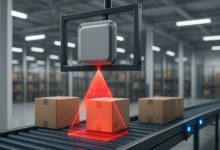Industrial IoT ROI Analysis: Manufacturing Cost Savings in Real Numbers
Get comprehensive Industrial IoT ROI analysis data. Manufacturing companies achieve $2M+ savings through smart factory implementation & optimization.

The Industrial Internet of Things (IIoT) is changing the way factories work—and the results are impressive. Companies that invest in smart manufacturing technologies are seeing real benefits, including cost savings and better performance.
An IIoT ROI analysis shows that most businesses earn returns of 15–30% within just two years of starting their projects. This guide takes a closer look at real-world data, proven strategies, and the measurable gains that show why IIoT is a smart investment for the future of manufacturing.
Understanding Industrial IoT ROI Fundamentals
Industrial IoT ROI analysis requires a systematic approach to measuring both direct and indirect benefits. Manufacturing companies must evaluate multiple cost centers, including equipment maintenance, energy consumption, labor efficiency, and quality control. The return on investment calculation encompasses initial hardware costs, software licensing, implementation services, and ongoing operational expenses.
Smart manufacturing systems generate value through predictive maintenance, reducing unplanned downtime by 35-50%. Production optimization algorithms increase overall equipment effectiveness (OEE) by 20-25%, while real-time monitoring systems decrease energy costs by 10-15%. These improvements translate directly to bottom-line savings that justify IIoT investments.
Connected devices and sensor networks provide manufacturers with unprecedented visibility into production processes. Data analytics platforms process millions of data points daily, identifying inefficiencies and optimization opportunities that human operators might miss. This comprehensive monitoring approach enables proactive decision-making and continuous improvement initiatives.
Quantifying Manufacturing Cost Savings Through IIoT
Real-world manufacturing cost savings from IIoT implementations demonstrate substantial financial benefits across multiple operational areas. Maintenance costs typically decrease by 25-35% through predictive analytics that prevent catastrophic equipment failures. Production efficiency improvements range from 15-28%, directly impacting revenue generation and capacity utilization.
Energy management systems integrated with IIoT platforms reduce utility expenses by 12-22% through intelligent load balancing and consumption optimization. Quality control enhancements minimize defect rates by 20-40%, reducing waste, rework costs, and customer complaints. These tangible savings accumulate rapidly, often exceeding initial investment costs within 18-24 months.
Labor productivity gains represent another significant cost reduction area. Automated data collection eliminates manual reporting tasks, freeing skilled workers for value-added activities. Real-time dashboards and mobile applications enable faster decision-making and response times, improving overall operational efficiency.
Predictive Maintenance: The Primary ROI Driver
Predictive maintenance represents the most significant ROI driver for Industrial IoT implementations. Traditional reactive maintenance approaches cost manufacturers approximately $50,000 per hour of unplanned downtime. IIoT-enabled predictive maintenance reduces this expense dramatically through early failure detection and scheduled interventions.
Vibration sensors, temperature monitors, and acoustic analysis systems continuously assess equipment health, identifying potential issues weeks or months before failure occurs. Machine learning algorithms analyze historical maintenance data to predict optimal service intervals, extending equipment lifespan by 20-30% while minimizing maintenance costs.
A major automotive manufacturer reported $2.3 million in annual savings after implementing predictive maintenance across their production lines. The system prevented 23 major equipment failures, avoided 145 hours of unplanned downtime, and reduced maintenance labor costs by 28%. These results demonstrate the substantial financial impact of proactive maintenance strategies.
Production Optimization and Efficiency Gains
Smart manufacturing systems optimize production processes through continuous monitoring and real-time adjustments. Digital twin technology creates virtual replicas of production lines, enabling manufacturers to test process changes without disrupting actual operations. This approach reduces trial-and-error costs and accelerates improvement implementation.
Manufacturing execution systems (MES) integrated with IIoT platforms provide comprehensive production visibility. Operators receive instant alerts about process deviations, quality issues, and equipment performance problems. This immediate feedback enables rapid corrective actions that prevent costly production disruptions.
Throughput optimization algorithms analyze production data to identify bottlenecks and inefficiencies. By automatically adjusting machine settings, scheduling, and resource allocation, these systems increase overall productivity by 18-25%. A consumer electronics manufacturer achieved a 22% increase in production output after implementing IIoT-driven optimization, generating $4.8 million in additional annual revenue.
Energy Management and Sustainability Benefits
Industrial IoT energy management systems deliver substantial cost savings while supporting sustainability initiatives. Smart sensors monitor electricity, gas, and water consumption across all production areas, identifying waste and optimization opportunities. Automated controls adjust lighting, heating, and cooling systems based on actual usage patterns and occupancy levels.
Power quality monitoring prevents equipment damage from voltage fluctuations and harmonics, extending machinery lifespan and reducing replacement costs. Demand response systems automatically reduce non-critical energy consumption during peak pricing periods, lowering utility expenses by 15-25%.
A steel manufacturing facility reduced energy costs by $1.2 million annually through IIoT implementation. The system optimized furnace operations, improved power factor correction, and eliminated energy waste during production changeovers. These improvements also reduced the facility’s carbon footprint by 18%, supporting corporate sustainability goals.
Quality Control and Defect Reduction
IIoT-enabled quality control systems dramatically reduce defect rates and associated costs. Computer vision systems inspect products at production speeds impossible for human operators, detecting defects with 99.7% accuracy. Statistical process control algorithms identify quality trends before they result in defective products.
Real-time quality monitoring prevents the production of non-conforming items, reducing waste, rework costs, and customer returns. Automated rejection systems remove defective products from production lines immediately, preventing contamination of good products. These improvements typically reduce quality-related costs by 30-45%.
A pharmaceutical manufacturer implemented IIoT quality control systems and reduced product recalls by 85%. The system prevented contaminated batches from reaching customers, avoiding $3.7 million in recall costs and protecting brand reputation. Quality improvements also increased customer satisfaction scores by 23%.
Implementation Costs and Investment Considerations
Industrial IoT ROI analysis must account for comprehensive implementation costs beyond initial hardware purchases. Software licensing, system integration, employee training, and ongoing support represent significant investment components. Typical IIoT projects require 12-18 months for full deployment and optimization.
Hardware costs vary significantly based on facility size and complexity. Basic sensor networks may cost $50,000-$200,000, while comprehensive smart factory implementations can exceed $5 million. Cloud-based platforms reduce upfront infrastructure costs but require ongoing subscription fees that must be included in ROI calculations.
Professional services for system design, installation, and commissioning typically represent 40-60% of total project costs. Employee training ensures successful adoption and maximizes system benefits. Change management initiatives address cultural resistance and promote user acceptance of new technologies.
Real-World Case Studies and Financial Results
A leading aerospace manufacturer invested $3.2 million in IIoT implementation across three production facilities. The system delivered $8.7 million in annual savings through predictive maintenance, energy optimization, and quality improvements. The 24-month ROI exceeded 150%, demonstrating the substantial financial benefits of comprehensive IIoT deployment.
An automotive parts supplier achieved $2.1 million in first-year savings from a $900,000 IIoT investment. Predictive maintenance prevented 18 major equipment failures, while production optimization increased throughput by 19%. Quality improvements reduced customer complaints by 67% and eliminated costly product recalls.
A food processing company realized $1.8 million in annual cost savings through IIoT-enabled energy management and waste reduction. The system optimized refrigeration systems, reduced packaging waste by 22%, and improved inventory management. These improvements also enhanced product freshness and extended shelf life.
Measuring Long-Term Value and Continuous Improvement
Industrial IoT ROI analysis extends beyond initial implementation benefits to encompass long-term value creation. Continuous improvement initiatives leverage accumulated data to identify new optimization opportunities. Machine learning algorithms become more accurate over time, delivering increasing returns on investment.
Digital transformation initiatives enable manufacturers to adapt quickly to market changes and customer demands. Flexible production systems can accommodate new products and processes without major infrastructure investments. This agility provides competitive advantages that translate to increased market share and profitability.
Data monetization opportunities emerge as manufacturers accumulate valuable operational and product performance information. This data can support new service offerings, partnership opportunities, and revenue streams beyond traditional manufacturing operations.
Risk Mitigation and ROI Protection
Cybersecurity investments protect IIoT systems from threats that could compromise operations and data integrity. Security incidents can negate ROI benefits and create substantial liability exposure. Comprehensive security frameworks, including network segmentation, encryption, and access controls, protect against cyber attacks.
Redundancy and backup systems ensure continued operations during equipment failures or maintenance activities. Cloud-based architectures provide scalability and disaster recovery capabilities that protect against data loss and extended downtime. These investments preserve ROI benefits and support business continuity.
Vendor selection and partnership strategies impact long-term ROI success. Established technology providers offer proven solutions, ongoing support, and upgrade paths that protect investment value. Comprehensive service level agreements ensure system availability and performance standards.
Future Trends and Emerging Technologies
Artificial intelligence and machine learning capabilities continue expanding IIoT value propositions. Advanced analytics platforms provide deeper insights and more accurate predictions, further improving ROI outcomes. Edge computing reduces latency and bandwidth requirements while enabling real-time decision-making.
5G networks will enhance IIoT capabilities through improved connectivity, lower latency, and support for massive device deployments. Augmented reality interfaces will improve operator training and maintenance procedures. These technological advances will drive additional cost savings and operational improvements.
Digital twin technology evolution will enable more sophisticated simulation and optimization capabilities. Blockchain integration will enhance supply chain transparency and traceability. These emerging technologies will create new ROI opportunities for forward-thinking manufacturers.
Conclusion: Maximizing Industrial IoT ROI
Industrial IoT ROI analysis demonstrates compelling financial benefits for manufacturers willing to invest in digital transformation. Average returns of 15-30% within two years, combined with ongoing operational improvements, justify comprehensive IIoT implementations. Predictive maintenance, production optimization, energy management, and quality control deliver measurable cost savings that accumulate rapidly.
Successful IIoT projects require careful planning, appropriate technology selection, and comprehensive implementation strategies. Manufacturers must evaluate their specific operational challenges and opportunities to maximize ROI potential. Professional guidance and proven solution providers can accelerate deployment and ensure optimal results.
The manufacturing industry’s digital transformation continues accelerating, driven by competitive pressures and customer demands. Companies that delay IIoT implementation risk falling behind more agile competitors. Early adopters gain sustainable competitive advantages through improved efficiency, quality, and responsiveness.
Investment in Industrial IoT technology represents a strategic imperative for modern manufacturers. The quantifiable benefits, demonstrated through real-world implementations, provide compelling evidence for digital transformation initiatives. Organizations that approach IIoT strategically will realize substantial returns while positioning themselves for long-term success in an increasingly connected manufacturing environment.











